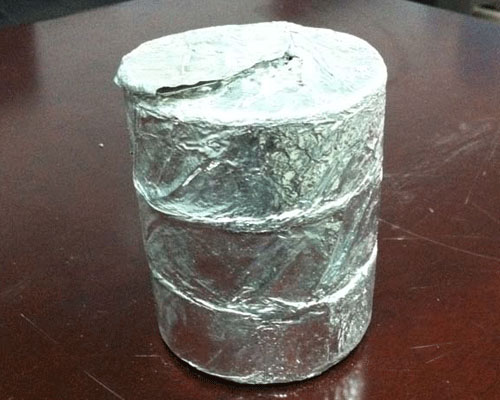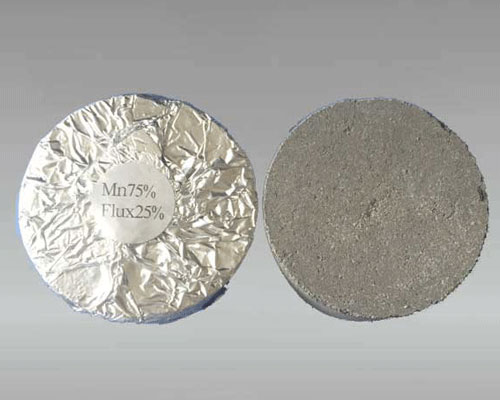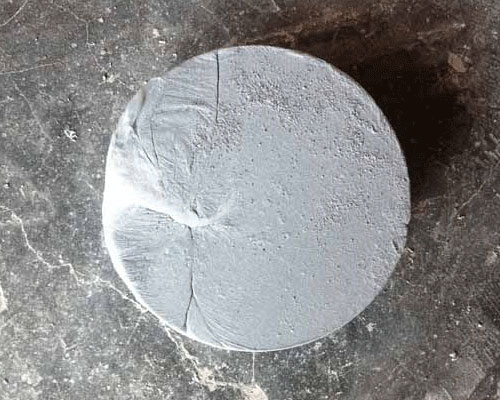Aluminum alloy additives are the important materials for aluminum alloy smelting. During the melting process of aluminum and aluminum alloy, it is necessary to add metals. Such as titanium, copper, manganese, iron, they can adjust the composition of the aluminum alloy. Metal additives are a new product that replaces aluminum master alloys. It is a block-shaped article formed by pressing pure metal powder and a flux with certain characteristics in a certain proportion and uniformly mixed.
Replacing master alloys with metal additives can simplify the aluminum alloy smelting process, save energy and raw materials, reduce production costs, and help accurately control alloy composition and improve product quality. Metal additives also have the characteristics of high metal content, small size, easy storage, transportation, and use.
Ti Additive

Ti Additive has a cylindrical shape, it is used to granule refine of aluminum alloy, adjust Ti purity in aluminum alloy and improve the tenacity.
Mn Additive

Mn Additive has a cylindrical shape, it is suitable for adjusting Mn content in aluminum alloy and improving alloy strength.
Fe Additive

Fe Additive has a cylindrical shape, it is used for adjusting Fe content in aluminum alloy.
Cu Additive

Cu Additive has a cylindrical shape, it is used to adjust Cu content in aluminum alloy.
Cr Additive

Cr Additive has a cylindrical shape, it is suitable for adjusting Cr content in aluminum alloy.
Strontium Modifier

Strontium Modifier has a tablet shape, it is used for lattice variation of aluminum alloy in precision casting.
How to Use Aluminum Alloy Additives
According to the amount of aluminum in the alloy and the actual yield in the additive, calculate the input amount of metal additive. Control the temperature of the molten aluminum at 730-750 ℃. Remove the packaging of Ti, Mn, Fe, Cu, Cr metal additives, and put the metal additive is put into the molten aluminum. Close the furnace door and simmer for 20-30 minutes. Then stir them by manual or electromagnetic for 10 minutes, and remove the slag. Next, adjust the temperature, simmer for 10 minutes. After fully stirring again, refine with refining agent for 15 minutes and then remove slag to achieve complete alloying.
After the metal additives are added to the melt, because the density of the metal additives is higher than that of the molten aluminum, they gradually move to the bottom of the furnace. The flux in the metal additive reacts with the oxide in the aluminum melt, and there is exothermic and slightly explosive decomposition. This reaction causes the additive lumps to gradually diffuse into the aluminum melt. At this time, after activation treatment, the pure metal powder with a very large specific surface area dissolves and diffuses rapidly in the aluminum melt. When the surface of the fine metal powder comes into contact with the aluminum melt, the element has a concentration difference everywhere in the aluminum melt, which promotes its concentration in the aluminum melt to tend to balance. This is the principle that very fine metal powder can quickly dissolve to achieve alloying.
Choosing Metal Additives
In the preparation of aluminum melt, it is common to add alloy elements to aluminum melt in the form of metal additives. According to relevant information, iron, manganese, and copper agents can safely replace aluminum-iron master alloy, aluminum-manganese master alloy and metallic copper. Metal additives have the advantages of high alloying element content, high actual yield, no sodium and chlorine, etc., and have both degassing and slag removal effects.
The following points should be considered when choosing metal additives
- Whether the actual yield of alloying elements meets the requirements.
- Whether the adding temperature is within the melting temperature range.
- Whether the composition of the solvent affects the quality of the final product.
- The effect on the environment.
